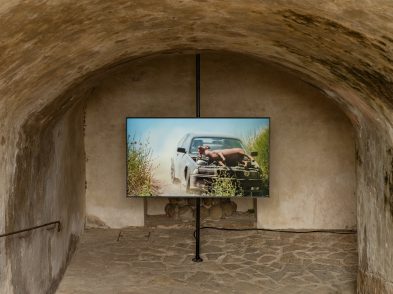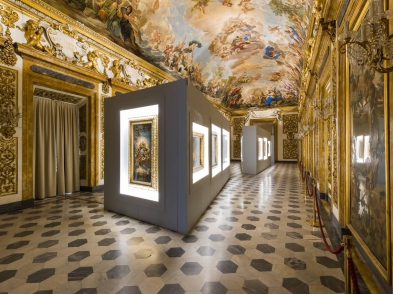The new exhibition at the Centro di Cultura Contemporanea Strozzina brings together rarely seen work by Francis Bacon, one of the last century’s most distinctive figurative painters, with five artists who have sought to express the competing forces-psychological and social, memory and reality, history and common myth-that they perceive underlie human existence today. For once, the low-ceilings and artificial light of the slightly claustrophobic underground galleries of the Strozzina provide a setting sympathetic to the work on display.
American composer and novelist Paul Bowles wrote that Francis Bacon resembled ‘a man about to burst from internal pressures.’ Those same pressures appear to afflict the figures at centre stage in the Irish-born British artist’s haunting paintings.
Often male, and usually naked, they are isolated by physical constraints and mental anguish. Twisting inside the skin of their own bodies, Bacon’s protagonists undergo tortures of existence in silence. It is the heightened colours around them that seem to scream.
Alongside the works by Bacon, who died in 1992, are those of five living artists (most currently based in Berlin, a city that fascinated the young Bacon in the 1920s) who embrace the breadth of media and methods available to contemporary practitioners. Means range from painting to film and from installations that occupy entire rooms to intense, framed photography hung on the wall. Not surprisingly, the figure predominates-but not exclusively-and two artists imply its presence without stating it.
The central character, however, is Bacon. Eight canvases spanning five decades, as well as three unfinished works found in his tiny, shambolic London studio at his death, offer a glimpse into the preoccupations of one of the key figures of twentieth-century painting.
Bacon was famously obsessed with man as meat but refused to attribute meanings to his images. He resisted attempts by critics to sap the work’s mystery and impact with psychological analysis. Consequently, a puzzling objectivity prevails.
But, living in the aftermath of destructive war, Bacon repeatedly took his captive figures to the point of dissolution. He liked the sense of constriction and in his paintings, a living, captive being often writhes in a cage, sometimes observed by others or accompanied by creatures derived from mythology. His largest images are typically fusions of violence, death and despair, of history and the present, and of potent symbols and ancient rituals.
To accompany the paintings in their familiar gold frames, the show has gathered items the artist owned. Books on Egyptian art and surgery are displayed with tracings and photographs of friends, who were also sitters, and of works by Michelangelo and Muybridge. Bacon used these instead of preparatory drawings, and they give a strong flavour of his process. They record the artist handling, folding, tearing and pinning a found image into a pose that interested him, roughing up its surface as if to wear down its individuality. Although few, these exhibits reveal a mind in search of forms to clothe ideas that dug out the bleak vision he harboured of humanity. ‘My whole life goes into my art,’ he said.
While by no means showing Bacon’s most important paintings, the rooms that include them nonetheless render the other work on show an anticlimax.
Romanian Adrian Ghenie gives his painted surfaces a volatile, expressive texture. ‘Every element in painting is inherently inert,’ Ghenie has said. ‘It’s all about how you activate them. Otherwise the work remains a still life.’ Paint is daubed, thrown, brushed, overlaid and pulled off to create a fragmentary, painterly environment in which unexpected events occur.
His paintings, often large in scale, have a cinematic quality. They offer a new atmosphere for the viewer to inhabit imaginatively while ensuring that this other world appears staged and contrived. It recalls Bacon’s approach although Ghenie’s fierce, excitable gestures explicitly proclaim psychological as well as visual impact. Bacon’s trance-like intensity when painting appears restrained.
In one painting by Ghenie, a figure claws at her own face as if in frustration; the spectral face of Hitler half-surfaces in another; and in a third the facial features of a scrubs-wearing surgeon are dissolved in paint like retribution for some evil medical experiment.
At the core of Swedish artist Nathalie Djurberg’s installations are intentionally crude stop-frame animations in which disturbing encounters are played out by plasticine puppets. These characters, vulnerably naked and unprotected by identity, travel an emotional spectrum that invariably includes conflict and violation.
In one film, a child attends to a mother, who proceeds to defile and almost consume her carer. In another work, Djurberg mixes the charming and disarming into an edgy combination. She creates a polystyrene cave the visitor can enter and a miniature fairy-tale house where one senses danger lurks.
Classic fairy tales frequently use symbols to probe social taboos, especially about sex and the body, and Djurberg works in that rich, ambiguous vain. Hanging over the ensemble is music, composed by Hans Berg, the mood of which at turns anticipates and contradicts the dramas unfolding in the darkened gallery.
The one Italian-based artist in the group is Arcangelo Sassolino. He brings the visitor back to the internal pressures in Bacon’s paintings. Using ropes set in unpredictable, irregular mechanical motion around thick wooden beams that obstruct both entrances to a corridor gallery, Sassolino emphasises the strength of physical forces like tension, weight and pressure to heighten senses and emotions. As the rope in this kinetic sculpture continues to tighten, the visitor fears for his safety. Then the motor stops and the tension slackens.
It is impossible to emerge from this show unaffected by its best work. Quite how to describe that impact is another matter. But as Bacon once commented about the world, ‘Since everything’s so meaningless, we might as well be extraordinary.’






